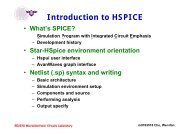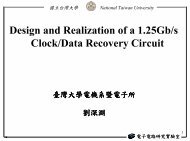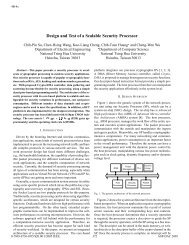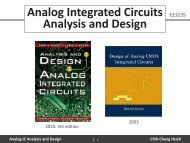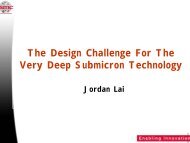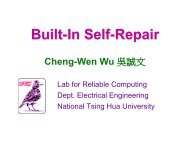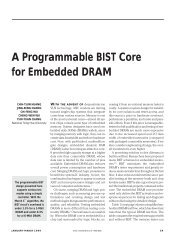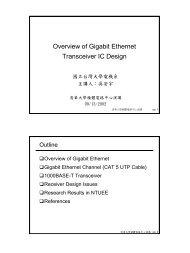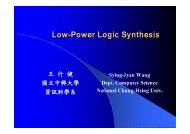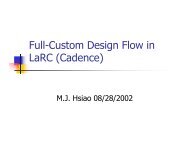Semiconductor Memory Testing - Laboratory for Reliable Computing
Semiconductor Memory Testing - Laboratory for Reliable Computing
Semiconductor Memory Testing - Laboratory for Reliable Computing
Create successful ePaper yourself
Turn your PDF publications into a flip-book with our unique Google optimized e-Paper software.
<strong>Semiconductor</strong> <strong>Memory</strong><br />
<strong>Testing</strong><br />
Cheng-Wen Wu 吳 誠 文<br />
Lab <strong>for</strong> <strong>Reliable</strong> <strong>Computing</strong> (LARC)<br />
Dept. Electrical Engineering<br />
National Tsing Hua University
Syllabus (1/5)<br />
• EE625300 <strong>Semiconductor</strong> <strong>Memory</strong> <strong>Testing</strong><br />
• Course Description<br />
− This is an advanced course <strong>for</strong> VLSI <strong>Testing</strong> and Design <strong>for</strong><br />
Testability, with emphasis on semiconductor memory<br />
testing. It is recommended that you take EE6250 (or<br />
equivalent) first.<br />
• Textbook<br />
− L.-T. Wang, C.-W. Wu, and X. Wen, Design <strong>for</strong> Testability:<br />
VLSI Test Principles and Architectures, Elsevier (Morgan<br />
Kaufmann), San Francisco, 2006<br />
• Reference<br />
− Ad J. van de Goor, <strong>Testing</strong> <strong>Semiconductor</strong> Memories:<br />
Theory and Practice, John Wiley & Sons, Chichester,<br />
England, 1991<br />
m01intro10.02 Cheng-Wen Wu, NTHU 2
Syllabus (2/5)<br />
• Format<br />
− Lectures, homework, and term project<br />
• Course Outline<br />
−<br />
−<br />
−<br />
−<br />
−<br />
−<br />
−<br />
−<br />
−<br />
−<br />
−<br />
−<br />
−<br />
−<br />
Introduction and fundamentals of IC testing<br />
RAM on-line testing<br />
RAM functional fault models<br />
RAM test algorithms<br />
RAM fault-coverage analysis<br />
Cocktail-March <strong>for</strong> testing word-oriented memories<br />
<strong>Memory</strong> built-in self-test (BIST)<br />
<strong>Memory</strong> built-in self-diagnosis (BISD)<br />
<strong>Memory</strong> redundancy repair<br />
<strong>Memory</strong> built-in self-repair (BISR)<br />
<strong>Memory</strong> failure analysis<br />
<strong>Testing</strong> flash memories<br />
Flash memory BIST<br />
Other advanced topics<br />
m01intro10.02 Cheng-Wen Wu, NTHU 3
• Grading Policy<br />
− Homework 30%<br />
Syllabus (3/5)<br />
− Midterm exams 40% (2x20%)<br />
− Project 30%<br />
• TAs<br />
− MS Lee 李 旻 昇 mslee@larc.ee.nthu.edu.tw<br />
− CY Chen 陳 靜 怡 cychen95@larc.ee.nthu.edu.tw<br />
• URL<br />
− http://larc.ee.nthu.edu.tw/~cww/n/625/6253/6253.html<br />
− http://larc.ee.nthu.edu.tw/~mslee/<br />
m01intro10.02 Cheng-Wen Wu, NTHU 4
Syllabus (4/5)<br />
• Tentative Schedule<br />
− 2/23: Introduction<br />
− 3/2: Fundamentals of IC testing<br />
− 3/9: RAM on-line testing (Prof. SK Lu)<br />
− 3/16: RAM functional fault models<br />
− 3/23: RAM test algorithms (Prof. JF Li)<br />
− 3/30: RAM fault-coverage analysis<br />
− 4/6: Cocktail-March <strong>for</strong> testing word-oriented<br />
memories<br />
− 4/13: <strong>Memory</strong> built-in self-test (BIST)<br />
− 4/20: Midterm Exam I<br />
− 4/27: <strong>Memory</strong> built-in self-diagnosis (BISD)<br />
m01intro10.02 Cheng-Wen Wu, NTHU 5
Syllabus (5/5)<br />
• Tentative Schedule<br />
− 5/4: <strong>Memory</strong> redundancy repair<br />
− 5/11: <strong>Memory</strong> built-in self-repair (BISR)<br />
− 5/18: <strong>Memory</strong> failure analysis<br />
− 5/25: Midterm Exam II<br />
− 6/1: <strong>Testing</strong> flash memories<br />
− 6/8: Flash memory BIST<br />
− 6/15: Other advanced topics<br />
− 6/18 (Friday): Project report due<br />
m01intro10.02 Cheng-Wen Wu, NTHU 6
Outline<br />
• Introduction & fundamentals of IC testing<br />
• RAM on-line testing<br />
• RAM functional fault models & test algorithms<br />
• RAM fault-coverage analysis & test generation<br />
• <strong>Testing</strong> word-oriented & multi-port memories<br />
• <strong>Memory</strong> built-in self-test (BIST) & built-in self-diagnosis<br />
(BISD)<br />
• <strong>Memory</strong> redundancy analysis and built-in self-repair<br />
(BISR)<br />
• <strong>Memory</strong> failure analysis<br />
• <strong>Testing</strong> non-volatile memories<br />
m01intro10.02 Cheng-Wen Wu, NTHU 7
Chapter 1: Introduction and<br />
Fundamentals of IC <strong>Testing</strong><br />
Cheng-Wen Wu 吳 誠 文<br />
Lab <strong>for</strong> <strong>Reliable</strong> <strong>Computing</strong><br />
Dept. Electrical Engineering<br />
National Tsing Hua University
• Scope of testing<br />
Outline<br />
• Defect level and fault coverage<br />
• Fault models<br />
− Classical faults<br />
− Switch-level faults<br />
− Timing faults<br />
− <strong>Memory</strong> faults<br />
• Test and testing<br />
• Design <strong>for</strong> testability (DFT)<br />
• Introduction to memory testing<br />
m01intro10.02 Cheng-Wen Wu, NTHU 9
What Are Tests<br />
Nuclear test, Nevada, 1953<br />
[science.howstuffworks.com]<br />
∗Olympic ticket test: Canada vs. Brazil<br />
∗[www.cbc.ca]<br />
∗Wafer test<br />
∗[www.nikhef.nl]<br />
∗Color vision test<br />
∗[colorvisiontesting.co<br />
m]<br />
∗Compression strength<br />
test<br />
∗[esquel-epp.com.my]
Test<br />
• Definition of test [Merriam-Webster]:<br />
− A critical examination, observation, or<br />
evaluation<br />
− The procedure of submitting a statement to<br />
such conditions or operations as will lead to its<br />
proof or disproof or to its acceptance or<br />
rejection<br />
• All products need to be tested<br />
• How do you test an advanced CPU<br />
• How do you test a DDR3 DRAM<br />
• Why do you test them
Typical IC Production Flow<br />
Wafer<br />
Probe Test<br />
Packaging<br />
Visual Inspection<br />
Final Test<br />
Marking<br />
QA Sample Test<br />
Shipping<br />
m01intro10.02 Cheng-Wen Wu, NTHU 12
• Economics!<br />
− Product quality<br />
− Product reliability<br />
Why <strong>Testing</strong><br />
Defect detected<br />
during IC test<br />
Defect detected<br />
during system test<br />
Defect detected<br />
during field test<br />
m01intro10.02 Cheng-Wen Wu, NTHU 13
<strong>Semiconductor</strong> Trends (ITRS 2005)<br />
Matel 1 Helf Pitch<br />
100<br />
90<br />
80<br />
70<br />
60<br />
50<br />
40<br />
30<br />
20<br />
10<br />
0<br />
Shrinking Pitch Size<br />
2005 2010 2015 2020<br />
# of Wirin<br />
18.5<br />
18<br />
17.5<br />
17<br />
16.5<br />
16<br />
15.5<br />
15<br />
14.5<br />
Increasing Wiring Levels<br />
2005 2010 2015 2020<br />
Year of Production<br />
Year of Production<br />
Gbits/cm<br />
50<br />
45<br />
40<br />
35<br />
30<br />
25<br />
20<br />
15<br />
10<br />
5<br />
0<br />
Increasing Gate Density<br />
2005 2010 2015 2020<br />
Power Supply Voltage<br />
1.2<br />
1<br />
0.8<br />
0.6<br />
0.4<br />
0.2<br />
0<br />
Decreasing Supply Voltage<br />
2005 2010 2015 2020<br />
Year of Production<br />
Year of Production<br />
m01intro10.02 Cheng-Wen Wu, NTHU 14
Test Cost<br />
90<br />
80<br />
70<br />
60<br />
50<br />
40<br />
30<br />
20<br />
10<br />
0<br />
0.5um 0.35um 0.25um 0.18um<br />
Test cost<br />
Package cost<br />
Silicon cost<br />
m01intro10.02 Cheng-Wen Wu, NTHU 15
DFT Usage Trend<br />
m01intro10.02 Cheng-Wen Wu, NTHU 16
Scope of <strong>Testing</strong><br />
• Engineering Test<br />
− Diagnostic Test<br />
∗ Fault location<br />
∗ Failure analysis<br />
∗ Design and/or process debugging<br />
• Manufacturing Test<br />
− Characterization Test<br />
∗ Per<strong>for</strong>mance characterization: parametric test<br />
∗ Reliability characterization: bathtub curve (aging)<br />
− Production Test<br />
∗ Simple parametric test<br />
∗ Functional test<br />
∗ Reliability screening (burn-in)<br />
m01intro10.02 Cheng-Wen Wu, NTHU 17
Fault<br />
• Fault: a physical defect in a circuit/system<br />
− Permanent fault: a fault that is continuous and stable, whose<br />
nature do not change be<strong>for</strong>e, during, and after testing<br />
∗ Affecting the functional behavior of the system permanently<br />
∗ A.k.a. hard fault or solid fault<br />
∗ Usually quite localized<br />
∗ Can be modeled<br />
− Temporary fault: a fault that is present only part of the time,<br />
occurring at random moments and affecting the system <strong>for</strong><br />
finite, but unknown, intervals of time<br />
∗ Transient fault: caused by environmental conditions<br />
∗ No well-defined fault model<br />
∗ Called soft error in RAM<br />
∗ Often assumed no permanent damage was done<br />
− Intermittent fault: caused by non-environmental conditions<br />
∗ Often repeatable<br />
∗ Can use permanent fault models and repeated test with stress<br />
m01intro10.02 Cheng-Wen Wu, NTHU 18
Fault Model and Error<br />
• Fault model: logical effect of a fault<br />
− Structure faults<br />
∗ Stuck-at faults: stuck-at-0 and stuck-at-1<br />
∗ Bridging (short) fault<br />
∗ Open (break) fault<br />
∗ Transistor stuck-on and stuck-open faults<br />
∗ Transition and delay faults<br />
− Functional faults<br />
∗ RAM coupling and pattern-sensitive faults<br />
∗ PLA cross-point faults<br />
• Error: manifestation of a fault that results in<br />
an incorrect module output or system state<br />
m01intro10.02 Cheng-Wen Wu, NTHU 19
Failure<br />
• Failure: deviation of a system from its<br />
specified behavior<br />
− Fault → error → failure<br />
• Failure mechanism: physical or chemical<br />
process that causes devices to malfunction;<br />
they manifest themselves on the circuit<br />
level as failure modes<br />
• Failure mode: the cause of rejection of<br />
failed device (effect of failure mechanism),<br />
such as open/short interconnections, or<br />
degraded parameter values<br />
m01intro10.02 Cheng-Wen Wu, NTHU 20
<strong>Testing</strong> and Fault Coverage<br />
• <strong>Testing</strong> is the process of determining whether a<br />
device functions correctly or not<br />
− How much testing of an IC is enough<br />
• Yield (Y) is the ratio of the number of good dies<br />
per wafer to the number of dies per wafer<br />
• Fault coverage (FC) is the measure of the ability<br />
of a test set T to detect a given set of faults that<br />
may occur on the DUT<br />
− FC = (#detected faults)/(#possible faults)<br />
m01intro10.02 Cheng-Wen Wu, NTHU 21
Defect Level and Fault Coverage<br />
• Defect level (DL) is the fraction of bad parts<br />
among the parts that pass all tests and are<br />
shipped<br />
− DL = 1 – Y**(1-FC)<br />
• FC refers to the real defect coverage (probability<br />
that T detects any possible fault---in F or not)<br />
• DL is measured in terms of DPM (defects per<br />
million), and typical values claimed are less than<br />
200 DPM, or 0.02%<br />
m01intro10.02 Cheng-Wen Wu, NTHU 22
Defect Level and Fault Coverage<br />
Required FC <strong>for</strong> DL = 200 DPM.<br />
Y (%)<br />
10<br />
50<br />
90<br />
95<br />
99<br />
FC(%)<br />
99.99<br />
99.97<br />
99.8<br />
99.6<br />
98<br />
m01intro10.02 Cheng-Wen Wu, NTHU 23
The <strong>Testing</strong> Problem<br />
• Given a set of faults in the circuit under test<br />
(CUT), how do we obtain a certain (small)<br />
number of test patterns which guarantees a<br />
certain (high) fault coverage<br />
− What faults to test (fault modeling)<br />
− How are test patterns obtained (test pattern<br />
generation)<br />
− How is test quality (fault coverage) measured<br />
(fault simulation)<br />
− How are test vectors applied and results evaluated<br />
(ATE/BIST)<br />
m01intro10.02 Cheng-Wen Wu, NTHU 24
Logic Fault Modeling: Stuck-at Fault<br />
a<br />
b<br />
c c stuck-at 0; c s-a-0; c s/0, or c/0<br />
a b c c(a/0) c(a/1) c(b/0) c(b/1) c(c/0) c(c/1)<br />
0 0<br />
0 1<br />
1 0<br />
1 1<br />
0<br />
0<br />
0<br />
1<br />
0<br />
0<br />
0<br />
0<br />
0<br />
1<br />
0<br />
1<br />
• Single (line) stuck-at fault: line has a constant value (0/1)<br />
• Multiple stuck fault: several single stuck-at faults occur at<br />
the same time<br />
− For a circuit with k lines, there are 2k single stuck faults, and 3 k -1<br />
multiple stuck faults<br />
0<br />
0<br />
0<br />
0<br />
0<br />
0<br />
1<br />
1<br />
0<br />
0<br />
0<br />
0<br />
1<br />
1<br />
1<br />
1<br />
m01intro10.02 Cheng-Wen Wu, NTHU 25
Test<br />
• A test <strong>for</strong> a fault f in circuit C is an input<br />
combination <strong>for</strong> which the output(s) of C is<br />
different when f is present than when it is<br />
not<br />
− A.k.a. test pattern, test vector, or experiment<br />
− A test x detects fault f iff C(x)⊕C f (x)=1<br />
• A test set <strong>for</strong> a class of faults F is a set of<br />
tests T such that <strong>for</strong> any fault f∈F, there<br />
exists t∈T such that t detects f<br />
m01intro10.02 Cheng-Wen Wu, NTHU 26
Fault Diagnosis<br />
• Fault detection: tells only whether a circuit<br />
is fault-free or not<br />
• Fault identification (location; isolation):<br />
provides the location and the type of the<br />
detected fault and other related in<strong>for</strong>mation<br />
• Fault diagnosis: includes both fault<br />
detection and fault identification<br />
m01intro10.02 Cheng-Wen Wu, NTHU 27
<strong>Testing</strong><br />
• <strong>Testing</strong> is a process which includes test<br />
pattern generation, test pattern application,<br />
and output evaluation<br />
− The quality of a test set depends on its fault<br />
coverage (FC) as well as its size<br />
− FC (typically 98-99% single stuck faults <strong>for</strong><br />
logic circuit) can be determined by fault<br />
simulation<br />
m01intro10.02 Cheng-Wen Wu, NTHU 28
Design <strong>for</strong> Testability (DFT)<br />
• A fault is testable if there exists a well-specified<br />
procedure to expose it, which can be<br />
implemented with a reasonable cost using current<br />
technologies<br />
− A circuit is testable with respect to a fault set when<br />
each and every fault in this set is testable<br />
• The term DFT refers to a class of design<br />
methodologies which put constraints on the<br />
design process to make test generation and<br />
diagnosis easier<br />
• Testability = controllability + observability<br />
m01intro10.02 Cheng-Wen Wu, NTHU 29
DFT Dilemma<br />
• No single methodology solves all VLSI testing<br />
problems<br />
• No single DFT technique is effective <strong>for</strong> all kinds<br />
of circuits<br />
• No DFT approach is free<br />
− Manpower and tool costs<br />
− Area overhead and per<strong>for</strong>mance penalty<br />
• Two classes of DFT techniques<br />
− Ad hoc guidelines<br />
− Structured (systematic) techniques<br />
m01intro10.02 Cheng-Wen Wu, NTHU 30
MUX Scan<br />
x<br />
Combinational<br />
Logic<br />
C<br />
T<br />
SI<br />
M D M D M D<br />
SO<br />
1. Switch to SR mode and check SR operation<br />
2. Initialize SR---load the first pattern<br />
3. Return to normal mode and apply test pattern<br />
4. Switch to SR mode and shift out the final state while<br />
setting the starting state <strong>for</strong> the next test. Go to 3<br />
m01intro10.02 Cheng-Wen Wu, NTHU 31
x<br />
LFSR<br />
Circular BIST<br />
Mux<br />
SI<br />
SO<br />
Combinational<br />
Logic<br />
MISR<br />
z<br />
MISR<br />
m01intro10.02 Cheng-Wen Wu, NTHU 32
Scan-Based PS-BIST with Test Points<br />
L<br />
F<br />
S<br />
R<br />
• • •<br />
PI<br />
P<br />
S<br />
M<br />
U<br />
X<br />
to cps<br />
• • •<br />
Combinational<br />
Logic<br />
• • •<br />
• • •<br />
• • •<br />
• • •<br />
S<br />
C<br />
from ops<br />
• • •<br />
PO<br />
M<br />
I<br />
S<br />
R<br />
Source: K.-T. Tim Cheng, UCSB<br />
m01intro10.02 Cheng-Wen Wu, NTHU 33
Why Investigating <strong>Memory</strong> <strong>Testing</strong><br />
• <strong>Memory</strong> testing is a more and more important issue<br />
− RAMs are key components <strong>for</strong> electronic systems<br />
∗ In Alpha 21264, cache RAMs represent 2/3 transistors and 1/3 area;<br />
in StrongArm SA110, the embedded RAMs occupy 90% area [Bhavsar,<br />
ITC-99]<br />
∗ <strong>Memory</strong> cores will represent more than 90% of SOC area by 2010<br />
[ITRS 2001]<br />
− Memories represent about 30% of the semiconductor market<br />
− Embedded memories are dominating the chip yield<br />
• <strong>Memory</strong> testing is more and more difficult<br />
− Growing density, capacity, and speed<br />
− Emerging new architectures and technologies<br />
− Embedded memories: access, diagnostics & repair, heterogeneity,<br />
custom design, power & noise, scheduling, compression, etc.<br />
• Cost drives the need <strong>for</strong> more efficient test methodologies<br />
− IFA, fault modeling and simulation, test algorithm development and<br />
evaluation, diagnostics, DFT, BIST, BIRA, BISR, etc.<br />
m01intro10.02 Cheng-Wen Wu, NTHU 34
Embedded <strong>Memory</strong> <strong>Testing</strong><br />
• Embedded memory testing is increasingly difficult<br />
− High bandwidth (speed and I/O data width)<br />
− Heterogeneity and plurality<br />
− Isolation (accessibility)<br />
− AC test, diagnostics, and repair<br />
• Test automation is required<br />
− Failure analysis, fault simulation, ATG, and<br />
diagnostics<br />
− BIST/BIRA/BISR generation<br />
m01intro10.02 Cheng-Wen Wu, NTHU 35
Typical RAM Production Flow<br />
Wafer<br />
Full Probe Test<br />
Laser Repair<br />
Packaging<br />
Marking<br />
Post-BI Test<br />
Burn-In (BI)<br />
Pre-BI Test<br />
Final Test<br />
Visual Inspection<br />
QA Sample Test<br />
Shipping<br />
m01intro10.02 Cheng-Wen Wu, NTHU 36
Off-Line <strong>Testing</strong> of RAM<br />
• Parametric Test: DC & AC<br />
• Reliability Screening<br />
− Long-cycle testing<br />
− Burn-in: static & dynamic BI<br />
• Functional Test<br />
− Device characterization<br />
∗ Failure analysis<br />
− Fault modeling<br />
∗ Simple but effective (accurate & realistic)<br />
− Test algorithm generation<br />
∗ Small number of test patterns (data backgrounds)<br />
∗ High fault coverage<br />
∗ Short test time<br />
m01intro10.02 Cheng-Wen Wu, NTHU 37


